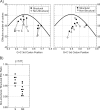Recombination and selection in the evolution of picornaviruses and other Mammalian positive-stranded RNA viruses
- PMID: 16956935
- PMCID: PMC1642140
- DOI: 10.1128/JVI.01076-06
Recombination and selection in the evolution of picornaviruses and other Mammalian positive-stranded RNA viruses
Abstract
Picornaviridae are a large virus family causing widespread, often pathogenic infections in humans and other mammals. Picornaviruses are genetically and antigenically highly diverse, with evidence for complex evolutionary histories in which recombination plays a major part. To investigate the nature of recombination and selection processes underlying the evolution of serotypes within different picornavirus genera, large-scale analysis of recombination frequencies and sites, segregation by serotype within each genus, and sequence selection and composition was performed, and results were compared with those for other nonenveloped positive-stranded viruses (astroviruses and human noroviruses) and with flavivirus and alphavirus control groups. Enteroviruses, aphthoviruses, and teschoviruses showed phylogenetic segregation by serotype only in the structural region; lack of segregation elsewhere was attributable to extensive interserotype recombination. Nonsegregating viruses also showed several characteristic sequence divergence and composition differences between genome regions that were absent from segregating virus control groups, such as much greater amino acid sequence divergence in the structural region, markedly elevated ratios of nonsynonymous-to-synonymous substitutions, and differences in codon usage. These properties were shared with other picornavirus genera, such as the parechoviruses and erboviruses. The nonenveloped astroviruses and noroviruses similarly showed high frequencies of recombination, evidence for positive selection, and differential codon use in the capsid region, implying similar underlying evolutionary mechanisms and pressures driving serotype differentiation. This process was distinct from more-recent sequence evolution generating diversity within picornavirus serotypes, in which neutral or purifying selection was prominent. Overall, this study identifies common themes in the diversification process generating picornavirus serotypes that contribute to understanding of their evolution and pathogenicity.
Figures







Similar articles
-
Frequency and dynamics of recombination within different species of human enteroviruses.J Virol. 2006 Jan;80(1):483-93. doi: 10.1128/JVI.80.1.483-493.2006. J Virol. 2006. PMID: 16352572 Free PMC article.
-
Recombination among picornaviruses.Rev Med Virol. 2010 Sep;20(5):327-37. doi: 10.1002/rmv.660. Rev Med Virol. 2010. PMID: 20632373 Review.
-
Full genome sequence analysis of parechoviruses from Brazil reveals geographical patterns in the evolution of non-structural genes and intratypic recombination in the capsid region.J Gen Virol. 2011 Mar;92(Pt 3):564-71. doi: 10.1099/vir.0.022525-0. Epub 2010 Dec 1. J Gen Virol. 2011. PMID: 21123543
-
Phylogeny of the Picornaviridae and differential evolutionary divergence of picornavirus proteins.Infect Genet Evol. 2004 Jun;4(2):143-52. doi: 10.1016/j.meegid.2004.03.001. Infect Genet Evol. 2004. PMID: 15157632
-
[Genomic instability in picornaviruses].Mol Biol (Mosk). 2002 Mar-Apr;36(2):286-95. Mol Biol (Mosk). 2002. PMID: 11969090 Review. Russian.
Cited by
-
RNA recombination: non-negligible factor for preventing emergence or reemergence of Senecavirus A.Front Vet Sci. 2024 Jan 24;11:1357179. doi: 10.3389/fvets.2024.1357179. eCollection 2024. Front Vet Sci. 2024. PMID: 38328259 Free PMC article. No abstract available.
-
Toward genetics-based virus taxonomy: comparative analysis of a genetics-based classification and the taxonomy of picornaviruses.J Virol. 2012 Apr;86(7):3905-15. doi: 10.1128/JVI.07174-11. Epub 2012 Jan 25. J Virol. 2012. PMID: 22278238 Free PMC article.
-
Screening respiratory samples for detection of human rhinoviruses (HRVs) and enteroviruses: comprehensive VP4-VP2 typing reveals high incidence and genetic diversity of HRV species C.J Clin Microbiol. 2009 Dec;47(12):3958-67. doi: 10.1128/JCM.00993-09. Epub 2009 Oct 14. J Clin Microbiol. 2009. PMID: 19828751 Free PMC article.
-
Genetic relationship between cocirculating Human enteroviruses species C.PLoS One. 2011;6(9):e24823. doi: 10.1371/journal.pone.0024823. Epub 2011 Sep 12. PLoS One. 2011. PMID: 21931857 Free PMC article.
-
Recombination in the evolution of enterovirus C species sub-group that contains types CVA-21, CVA-24, EV-C95, EV-C96 and EV-C99.PLoS One. 2014 Apr 10;9(4):e94579. doi: 10.1371/journal.pone.0094579. eCollection 2014. PLoS One. 2014. PMID: 24722726 Free PMC article.
References
-
- Andersson, P., K. Edman, and A. M. Lindberg. 2002. Molecular analysis of the echovirus 18 prototype: evidence of interserotypic recombination with echovirus 9. Virus Res. 85:71-83. - PubMed
-
- Ando, T., J. S. Noel, and R. L. Fankhauser. 2000. Genetic classification of “Norwalk-like viruses.” J. Infect. Dis. 181(Suppl. 2):S336-S348. - PubMed
-
- Baranowski, E., C. M. Ruiz-Jarabo, and E. Domingo. 2001. Evolution of cell recognition by viruses. Science 292:1102-1105. - PubMed
-
- Belliot, G., H. Laveran, and S. S. Monroe. 1997. Detection and genetic differentiation of human astroviruses: phylogenetic grouping varies by coding region. Arch. Virol. 142:1323-1334. - PubMed
MeSH terms
Substances
LinkOut - more resources
Full Text Sources

